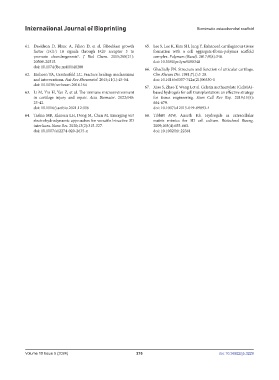Page 224 - IJB-10-5
P. 224
International Journal of Bioprinting Biomimetic osteochondral scaffold
61. Davidson D, Blanc A, Filion D, et al. Fibroblast growth 65. Lee S, Lee K, Kim SH, Jung Y. Enhanced cartilaginous tissue
factor (FGF) 18 signals through FGF receptor 3 to formation with a cell aggregate-fibrin-polymer scaffold
promote chondrogenesis*. J Biol Chem. 2005;280(21): complex. Polymers (Basel). 2017;9(8):348.
20509-20515. doi: 10.3390/polym9080348
doi: 10.1074/jbc.m410148200
66. Ghadially FN. Structure and function of articular cartilage.
62. Einhorn TA, Gerstenfeld LC. Fracture healing: mechanisms Clin Rheum Dis. 1981;7(1):3-28.
and interventions. Nat Rev Rheumatol. 2015;11(1):45-54. doi: 10.1016/s0307-742x(21)00330-1
doi: 10.1038/nrrheum.2014.164
67. Xiao S, Zhao T, Wang J, et al. Gelatin methacrylate (GelMA)-
63. Li M, Yin H, Yan Z, et al. The immune microenvironment based hydrogels for cell transplantation: an effective strategy
in cartilage injury and repair. Acta Biomater. 2022;140: for tissue engineering. Stem Cell Rev Rep. 2019;15(5):
23-42. 664-679.
doi: 10.1016/j.actbio.2021.12.006 doi: 10.1007/s12015-019-09893-4
64. Taskin MB, Klausen LH, Dong M, Chen M. Emerging wet 68. Tibbitt MW, Anseth KS. Hydrogels as extracellular
electrohydrodynamic approaches for versatile bioactive 3D matrix mimics for 3D cell culture. Biotechnol Bioeng.
interfaces. Nano Res. 2020;13(2):315-327. 2009;103(4):655-663.
doi: 10.1007/s12274-020-2635-x doi: 10.1002/bit.22361
Volume 10 Issue 5 (2024) 216 doi: 10.36922/ijb.3229

